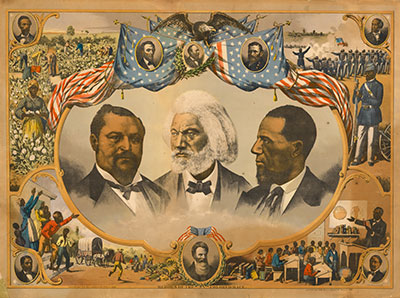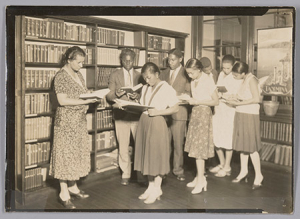Black History Month Resources
More events, online exhibitions, and resources can be found on the Smithsonian’s Black History Month pages.
Go back to the main Resource Library for conversations that matter here.
Podcasts & Oral Histories
Sidedoor Podcast, from the Smithsonian Institution
- Lena Richard: America’s Unknown Celebrity Chef
- Singing the Gender Bending Blues
- The Monumental Imagination of Augusta Savage
A Little Freedom is a Dangerous Thing, from A Very OK Podcast (Oklahoma Historical Society)
Collected, a project of the African American History Curatorial Collective at the National Museum of American History
- Episode 1: Black Feminism Re-rooted
- Episode 2: Collective Re-rooted
- Episode 3: Identity Politics Re-rooted
- Episode 4: Self-Care Re-rooted
- Episode 5: Intersectionality Re-rooted
- Episode 6: The Future of Black Feminism Re-routed
Oral histories discussing immigration from the “Honoring our Heritage” collection at the Arab American National Museum
- Abuharaz video documenting their immigration story
- Mohamed family digital scrapbook
Image: Artwork for the Sidedoor episode, Lena Richard: America’s Unknown Celebrity Chef.
Online Exhibitions
The Negro Motorist Green Book, an exhibition offers an immersive look at the reality of travel for African Americans in mid-century America and how the annual guide served as an indispensable resource for the nation’s rising African American middle class and evidence of a vibrant business class.
Hip-Hop Origins, from the National Museum of African American History and Culture. Hip-hop started with parties in the Bronx and has grown to a level of worldwide recognition and influence. Take a journey across the country as we explore hip-hop through its stories and objects.
Wilmington Massacre and Coup d’etat of 1898, from Cape Fear Museum (Wilmington, NC). In 1898, North Carolina Democrats used threats and intimidation to stop African Americans from voting. Two days after the contested election, a mob of armed white men marched to the office of The Daily Record, the local African American newspaper, and set it on fire.
The Tulsa Race Massacre, from the Oklahoma Historical Society (Oklahoma City, OK). The Tulsa Race Massacre challenges our understanding of early Oklahoma as a frontier offering freedom, opportunity, and progress to anyone. The events that transpired on the night of May 31, 1921, and the following day are difficult to comprehend, and the fact that it happened is frightening. We have a responsibility to face this chapter in order to know our history.
Race: Are We So Different?, the first in a 3- part series, created by the American Anthropological Association and extended into a Google Arts and Culture exhibit by the Museum of Us (San Diego, CA). View the other exhibits- Race and Education and Social Stratification.
Another Field of Firsts: African-American Aviators of Prince George’s County, created by College Park Aviation Museum (College Park, MD).
Image: Boombox used by Public Enemy. Collection of the Smithsonian National Museum of African American History and Culture, Gift of Public Enemy
Videos
Virtual Scholar Talks, from Smithsonian Affiliations
- The Legacy of the Green Book
- Michael Jordan: A Re-evaluation
- Let’s Talk! Talking about Race with Children in Museums
- African American Women’s Activism in Historical Perspective
- Lena Richard and Julia Child: Two Women who Changed Culinary History
Dreaming of Colored People: Black Women and the St. Luke Finance Corporation in the 1920s, Museum of American Finance (New York, NY). African American women in 1920s-era Harlem participated in real estate and other investment schemes for complex reasons. The St. Luke Finance Corporation was one such scheme that showed great promise but struggled against structural and institutional inequities as well as criticism from some sectors of the Black community.
Proud Warriors: African American Combat Units in WWII, from the Wisconsin Veterans Museum (Madison, WI). This is a virtual book talk with Dr. Alexander Bielakowski, University of Houston assistant professor of history, focusing on the role of African Americans during World War II.
From the Weitzman National Museum of American Jewish History (Philadelphia, PA)
- Deconstructing Racism to Reconstruct Judaism: The Story of a Pilgrimage Down South share powerful stories from a pilgrimage focused exclusively on American Jews of African descent grappling with the United States’ foundational sins and the necessary work for healing and teshuvah.
- Koshersoul Book Release with Michael Twitty and Joan Nathan explores the cultural crossroads of Jewish and African diasporic cuisines and related issues of memory, identity, and food.
From the National Museum of the Pacific War (Fredericksburg, TX):
- A discussion about the roots of civil rights in WWII history and the role of African Americans in the Pacific War
- Retired Generals discuss diversity in the military
K-12 Resources
Talking about Race, National Museum of African American History & Culture. Resources for teachers, caregivers, and other audiences to make the world a more equitable and just place for all.
National Civil Rights Museum (Memphis, TN) Learning Links for educators, lesson plans and activities that can be used by children, parents or families together.
- King: A Legacy Remembered
- Resources for Exploring and Understanding Civil and Human Rights
- Creating Change through Action
Birmingham Civil Rights Institute (Birmingham, AL): Lesson Plans for K-12 students
Spy, Think, Ponder Art Cards from the Rockwell Museum (Corning, NY)
The Spy, Think, Ponder art card sets highlight works of art in The Rockwell’s collection. They incorporate youth-friendly language and fun prompts to engage children’s imagination. Children are exposed to using Visual Thinking Strategies by looking, making observations, thinking about what they see and wondering more about the topics presented.
K-12 video resources about African Americans in World War II from the National Museum of the Pacific War (Fredericksburg, TX)
Image: Heroes of the Colored Race, a hand-colored chromolithograph on paper by Joseph Hoover, 1830 – 1913. Credit- National Portrait Gallery.
Smithsonian Learning Lab Collections
The Smithsonian Learning Lab is a free, interactive platform for discovering digital resources.
- My Beautiful Skin, age-appropriate resources and activities for having conversations about race with young learners.
- Black History Month with the National Portrait Gallery
- George Washington Carver Museum, part of the City of Austin Parks and Recreation Departmetn
- Essential Historian Skills: Black Resistance- The Journey to Equality, from the National Museum of African American History and Culture
- North Star, a digital journey of African American History from the National Museum of African American History and Culture
Image: Rainbow wig worn by George Clinton. Collection of the Smithsonian National Museum of African American History and Culture, Gift of Love to the planet
Resource Compilations
Warren M. Washington collection from the National Center for Atmospheric Research archives, managed by the University Corporation for Atmospheric Research (Boulder, CO). The collection documents his scientific and professional activities as well as his significant contributions to the enhancement of opportunities for people of color in science.
Black History is Oklahoma History, from Oklahoma History Center (Oklahoma City, OK). As new voices call for change, the OHS stands committed to its mission to collect, preserve, and share the history and culture of all Oklahomans. Browse free resources related to the Black experience in Oklahoma in these pages.
Articles from Financial History Magazine, a publication of the Museum of American Finance (New York, NY)
- Gender and the Dismal Science
- Free (Business) People of Color
- New Deal or Raw Deal? Black Americans in the Roosevelt Years
- ‘A Commercial Emancipation’ for the Negro: Financing Black Business in the 1920s
- Financial Discrimination and Innovation
- Go to Durham, You Need the Inspiration: How Black Wall Street Flourished in a Piedmont Railroad and Tobacco Town
- For the Love of Money: Blacks on US Currency
Publications, research, K-12 educator resources and more from the Kentucky Historical Society (Frankfort, KY), which is dedicated to providing historic perspective and context to current events, especially as we look to end racial injustice and systemic racism. The resources offered cover a wide range of topics and represent the work of programs across our agency.
Freedom Stories: Unearthing the Black Heritage of Appalachia, from the International Storytelling Center (Jonesborough, TN) is an ongoing series that marries performance and discussion, connecting prominent Black storytellers, humanities scholars, and community leaders with the public to trace the history and the role that storytelling has played in both African and Appalachian experience.
Black History in Psychology, from the University of Akron, Cummings Center for the History of Psychology (Akron, OH). Geared towards high school and college students, these resources examine the contributions of Black psychologists and the broader intersections of psychology and race.
Image: A gelatin silver print of male and female students standing and reading in a library at the Manual Training and Industrial School for Colored Youth in Bordentown, New Jersey. Collection of the Smithsonian National Museum of African American History and Culture, Gift of Howard and Ellen Greenberg
Blogs and Articles
Explore resources on history makers, videos, and Black voices and blogs from Conner Prairie (Fishers, IN)
Desegregation in the Military and Juneteenth: How Wisconsin Was There at the Beginning, by the Wisconsin Veterans Museum (Madison, WI)
Black Musicians and Music from the Birthplace of Country Music (Bristol, VA). Full list of Black History Month resources here.
- A Celebration of Black Contributions in Country Music
- Off the Record: Big Mama Thornton and Nina Simone
- Songs of Our Native Daughters: A Note from a Native Daughter
Image: Pinback button stating “Black Lives Matter Everyday”, from MMM 20th Anniversary. Collection of the Smithsonian National Museum of African American History and Culture.






![Black Lives Matter button A black pinback button. It reads [BLACK/LIVES/MATTER/everyday] in white. There are several small scratches on the pin. The back is metal and does not have anything on it other than a pin at the top.](https://affiliations.si.edu/wp-content/uploads/2023/12/blm-button-nmaahc-300x300.jpg)
